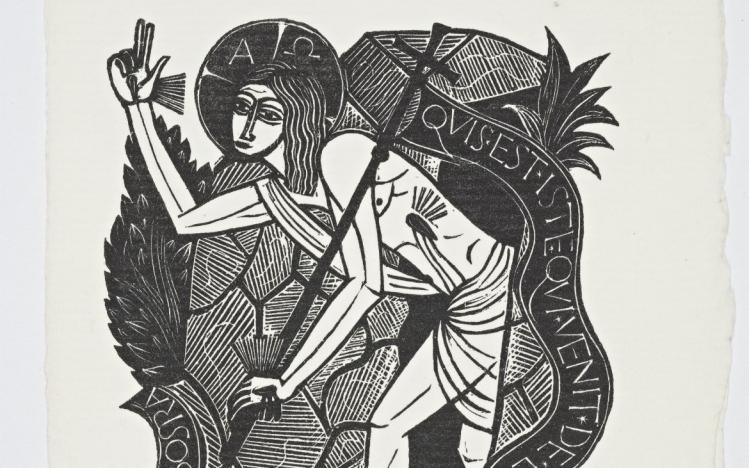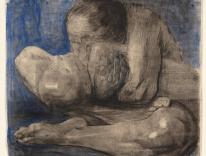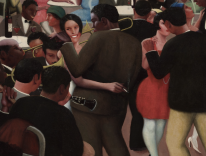
Like many people living in urban and suburban areas during the COVID-19 lockdowns, I woke each morning to a slightly, yet significantly, altered habitat. The commuter traffic rolling like a riotous river outside the bedroom window had hushed; the constant hum from the distant motorway was noticeably softer. Birds sang through this new morning quiet and our own slow-to-wake voices gained clarity. Marginal creatures living on the outskirts of the city center—foxes, deer, badgers—swiftly moved in to explore the new breathing space. Skies looked bluer; stars appeared brighter. Satellites sent back images of water along city shorelines changing rapidly from muddy brown to turquoise blue.
This rollback of human activity, an “anthropause” in the epoch of the Anthropocene, provided a glimpse within our ordinary lives of the profound influence we exert on the world around us, of how intimately yet often unwittingly we shape the habits of creatures with whom we live and upon whom we so thoroughly depend. More starkly, the theologian and ethicist David Clough has deemed the COVID-19 crisis an “animal apocalypse”: an unveiling of vast disorder in our relationship with animals and material creation that is disastrous not only for them but also for us. The zoonotic origin of the virus is itself a telling symptom of these fractured dynamics. It is at least becoming clear that the uncertain waters the pandemic has plunged us into are part of the ecological crisis that continues almost unabated. How will we respond to what we are collectively and individually witnessing? Is a return to the old “normal” inevitable or does this moment invite us to forge “new patterns of peaceable creaturely living,” as Clough urges?
The most palpable shifts within the history of our species have been precipitated by our innate capacity to imagine things otherwise. If the recent upheavals in our patterns of living have provided some stimulus for broadening and nourishing our imagination of what may be, as Christians we are also invited to ask what it means to live in light of the Resurrection—this most radical of glimpses into the new order given to us. What bearing does this anticipation of the new creation in Christ have upon our relationships with the “more than human” world? How do we live in light of the Resurrection this side of the eschaton? A wood engraving by the artist David Jones, titled Resurrection, might help us move forward in our exploration of these questions.
Just two years after his experimental Nativity engraving, Jones had become one of the finest engravers in Britain and was commissioned by Golden Cockerel Press to create a series of illustrations for several books produced on a hand-operated press with handmade paper. Golden Cockerel Press, together with members of the Society of Wood Engravers, embraced book production as a political, social, and ecological intervention, perceiving their post–World War I Britain as driven by commercialism, efficiency, and speed above all else. For these artisans, human artifacts and the technologies with which we make them are never neutral; they actively shape our relations with one another, with other creatures, and with the divine.
In the late 1920s, Jones would complete illustrations from engraved wood blocks for the stories of Jonah and the whale, Noah and the flood, and later, in copper, for Coleridge’s poem “The Rime of the Ancient Mariner.” The commonality in subject matter across these major projects is revealing: each is the story of an epic voyage of descent and ascent in which the principal characters undergo severe trial—all, notably, trials by water—in the passage to redemption. Jones’s attraction to these stories was not abstract but profoundly personal. He had crossed the Strait of Dover only a few years earlier as a soldier in World War I “by misadventure,” as he would later characterize it, and he suffered in the wake of the war. Yet it was also during wartime when, as Jones recounts, he became a Catholic “inside,” having witnessed a makeshift Mass not far from the trench line. On his return, he would formally convert. In his introduction to Coleridge’s poem, Jones reflects on the trope of Christ the Mariner: “What is pleaded in the Mass is precisely the argosy or voyage of the Redeemer, his entire sufferings, death, resurrection and ascension. It is this that is offered on behalf of us argonauts and the whole argosy of mankind and indeed in some sense of all earthly creation, which, as Paul says, suffers a common travail.” As Jones’s poetry and visual art attest, he gradually explored what it means to read not only these biblical stories, but his own—and indeed all creation—in light of the “argosy of the Redeemer.”
Made in 1926 as the dust cover illustration for The Book of Jonah, Jones’s Resurrection invites readers to perceive the plight of Jonah in the retrospective light of the Passion of Christ. It is one of the few typologies explicitly drawn by Jesus in the Gospels: “For just as Jonah was in the belly of the sea monster, so for three days and three nights the Son of Man will be in the heart of the earth” (Matthew 12:40). As Cyril of Jerusalem would later gloss this foretelling of Christ’s death and resurrection, “The one was cast into a whale’s belly: but the other of His own accord went down, where the invisible whale of death is. And He went down of His own accord, that death might cast up those whom he had devoured.” This “invisible whale of death” is not limited to the pain and loss of our physical death, but signifies those invisible bonds of “death-in-life” that we come to regard as inevitabilities. As Geoffrey Preston writes,
This includes all those social forms and dogmas which constitute fate for so many people, those tyrants of the market-place and the home, the worship of the national spirit, the traditions which fall and become inflexible conventions or, worse still perhaps, complacencies, and those insidious authorities of unreason and passion that speak through propaganda and the mass-media.
It is into these contexts that the voices of the prophets still speak and help us perceive anew “how beautiful upon the mountains are the feet of the messenger who announces peace, who brings good news, who announces salvation” (Isaiah 52:7).
Jones’s engraving for The Book of Jonah brings us to this threshold where the risen Lord emerged from the dark mouth of the tomb. His right arm is raised before him in a gesture of blessing and peace. He carries the empty cross as his scepter, and his wounds are now transfigured as shining regalia. The cruciform halo crowns him in his divinity as “the Alpha and Omega, the first and the last, the beginning and the end” (Revelation 21:6). As the Eternal Word, the journey of his singular human life reaches through time, carrying all in the wake of his healing grace, “from before Swanscombe Man to after Atomic Man” as Jones reflects elsewhere. The royal banner flowing from the cross bends like a river around the contours of the rock, recalling “the river of the water of life...flowing from the throne of God and of the Lamb” in the Revelation of John. Here, too, “on either side of the river is the tree of life...and the leaves of the tree are for the healing of the nations” (Revelation 22:1–2). The words inscribed on the banner inaugurate this new creation in the interrogative: QUIS EST ISTE QUI VENIT DE EDOM TINCTIS VESTIBUS DEBOSRA, or “Who is this that cometh from Edom, with dyed garments from Bozrah?” (Isaiah 63:1). It’s a passage that would take on Eucharistic associations through its incorporation into the Tridentine Mass on Holy Wednesday, where it is read before the Passion story from the Gospel of Luke.
In Jones’s engraving, the side wound from which these streams of blood and water still flow appears to gleam. This open wound, which confirms Christ’s death while he was still on the cross, becomes the inexhaustible source of life for us “argonauts” who continue our “common travail.” Yet here Jones subtly presses this devotion to the wounds of Christ further, for the pod-like shape of this wound echoes the form Jones gives to the sheltering womb of the land that cradles both Mary and Jesus in his Nativity engraving. This one “whom the whole world cannot hold” was enclosed not only in Mary’s womb, but also in Terra Mater, and he was enclosed once more in “the heart of the earth” in his death. In the Resurrection, he is revealed most fully, as Julian of Norwich boldly writes, as “the true mother of life and of all things.” These engravings’ suggestive identification of the land with the Lord’s body would grow in Jones’s imagination and would be woven throughout his later poetry. As he bore witness to the increasing destruction of the woods, rivers, and hills of his native Britain by the sweeping currents of industrialism and the rise of “the technocratic,” he perceived in this violence the ongoing wounding of the Lord himself. In his poem “The Sleeping Lord” he asks, “Is the configuration of the land / the furrowed body of the lord / are the scarred ridges / his dented greaves / Do the trickling gullies / yet drain his hog-wounds / Does the land wait the sleeping lord / or is the wasted land / that very lord who sleeps?”
Julian of Norwich also imagines with startling clarity the “more than human” world’s participation in Christ’s Passion: “And all creatures capable of suffering pain suffered with him.... The firmament of the earth failed out of sorrow in their very nature at the moment of Christ’s death; for it is natural to them to recognize him as their God, in whom all their powers have their foundation.... And so those who were his friends suffered pain because of love.” The friendship of Christ extends beyond the circle of the chosen twelve and beyond the naves of our churches, where we celebrate the reparation of human relations not only with the divine, but also, through the Incarnation, with “the planets and the elements.” As Pope Francis exclaims in Laudato si’, “the Eucharist is itself an act of cosmic love.” Through Christ’s sign-making with the bread and wine—these “quasi-artefacts” cultivated by human hands through the ages—he gathers up all creatures and offers them to the Father anew. By contrast, writes Rowan Williams, “matter as hoarded or dominated or exploited speaks of the distortion and ultimate severance of relationship, and as such can only be a sign of death. The matter of the Eucharist carrying the presence of the risen Jesus, can only be a sign of life, of triumph over the death of exclusion and isolation.”
The Resurrection calls us to more than simply a return to “normal,” just as it invites us to more than attempts to recover a lost Eden. The new creation is not made out of nothing; it is rather a making new with the old, with all that has been and is coming to be in the voyage of earthly creation through the millennia. Living in the light of this new creation means being prepared to meet the living Lord in any guise he may assume, not only in one another but in creatures of all shapes and sizes. Such encounters can change the course of history. They shift the rudder ever so slightly. But over the long haul, even a slight shift is enough to bring us to a different shore. Until then, as John tells us, we may remember, “Beloved, we are God’s children now; what we will be has not yet been revealed. What we do know is this: when he is revealed, we will be like him, for we will see him as he is” (1 John 3:2). In this dawn of fragile anticipation, the circle of creaturely existence opens like the omega to its final union with the Creator, shared now in the open bread bowl and rounded cup by which we are made partakers in his presence.
Please email comments to [email protected] and join the conversation on our Facebook page.
Previous Story
Belief & Disbelief
Next Story
Bad Education


